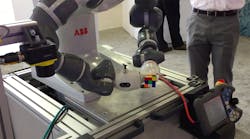We can run the world without consuming the earth. That was a sentiment expressed multiple times at ABB Consumer World this week in Houston, and it was one that ABB CEO Ulrich Spiesshofer highlighted during his morning keynote early in the week.
An airplane can now fly around the world without consuming a single drop of fuel. That was achieved for the first time last year by Solar Impulse 2, Spiesshofer noted, and it’s just one indication of what can be achieved as technology advances.
Advancing technologies also include the sheer connectedness of devices. There are some 7 billion industrial devices connected to the Internet today, and more than 25 billion are expected by 2020, which is not nearly as far off as it used to sound. “Today, ABB is leading in this field,” Spiesshofer said, adding that its motors, with connected, intelligent sensors, can provide “better uptime, higher speed and better yield of industrial processes.”
Artificial intelligence (AI) continues to improve. IBM has been vocal about everything its Watson technology can do, and most people are familiar with its defeat in 2011 of two of Jeopardy’s greatest champions, Ken Jennings and Brad Rutter. More recently, Go world champion Lee Se-dol was defeated in four out of five games played against Google’s AI technology AlphaGo.
Though these might seem like frivolous pursuits to some, they demonstrate AI’s ability to enable machine learning. And that learning is in turn enabling industrial robots to take on new challenges. “We use artificial intelligence today to give our robots completely new purposes,” Spiesshofer said.
ABB’s collaborative robot Yumi showed off its learning capabilities this week at the exhibition. “Yumi can solve a Rubik’s Cube in less than two minutes by just looking at it and learning itself,” Spiesshofer noted. (He also conceded that it takes him a good 20 minutes to solve a Rubik’s Cube. I concede that the only time I “solved” a Rubik’s Cube was when I peeled off and replaced the colored stickers while my friends weren’t looking.)
The video shown here, taken at ABB Customer World, shows Yumi taking pictures of each side of the cube to then figure out the best way to solve it. He was slowed down to about half his usual speed for demonstration purposes, but it typically takes him 26-27 moves to complete.
Though the fourth industrial revolution is often equated with the Industrial Internet of Things (IIoT), AI is a key factor as well. “The first three industrial revolutions were all about replacing muscle power with machines,” Spiesshofer said. “The fourth revolution replaces brain work with artificial intelligence.”
The reach and scope of that revolution is much wider than it’s ever been also, Spiesshofer said. It goes beyond the factory walls and goes anywhere.
“We need to use that as an opportunity, but at the same time, take the people with us,” he said. “This is an unprecedented speed of change, and it has a direct impact on our people.”
It’s change that creates unease among plant workers, who see automation and robotics as a threat to their livelihoods.
The previous three industrial revolutions saw jobs changing from generation to generation, but technology is moving so fast these days that job changes might be necessary within a generation. “One of the key tasks that we face is we have to take our people with us in the fourth industrial revolution. We need to avoid creating anxiety,” Spiesshofer said. “Every industrial revolution so far has changed jobs, but the amount of work in the world has always gone up. If we play this intelligently together, the fourth industrial revolution also will create work. It’s our responsibility between enterprise, education and government to take the people with us.”
Leaders relevant to this article:

